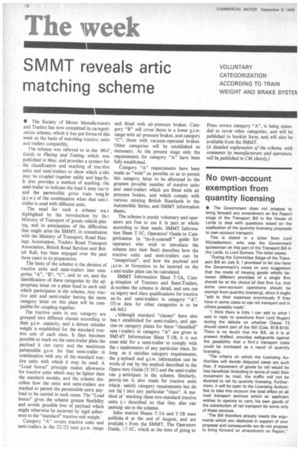SMMT reveals artic matching scheme
Page 20

If you've noticed an error in this article please click here to report it so we can fix it.
• The Society of Motor Manufa cturers and Traders has now completed its ca tegori zation scheme, which it has put forward this week as the basis of matching tractivc units and trailers compatibly.
The scheme was referred to in the MoT Guide to Plating and Testing, which was
published in May, and provides a systern for the classification and marking of tractive units and semi-trailers to show which u nits may be coupled together safely and lega fly.
It also provides a method of marking the semi-trailer to indicate the load it may carry and the permissible gross train weig ht (g.t.w.) of the combination when that sem itrailer is used with different units.
The need for such a scheme wa s highlighted by the introduction by tho Ministry of Transport of goods vehicle plating, and in anticipation of the difficulties that might arise the SMMT, in consultation with the Ministry of Transport, Road Haulage Association, Traders Road Transport Association, British Road Services and British Rail, has been engaged over the past three years in its preparation.
The basis of the scheme is the division of tractive units and semi-trailers into categories "A", "B", "C", and so on, and the identification of these categories by the appropriate letter on a plate fixed to each unit which participates in the scheme. Any tractive unit and semi-trailer having the same category letter on this plate will be compatible for coupling together.
The tractive units in any category are grouped into different classes according to their g.t.w. capacity, and a datum unladen weight is established for the standard tractive unit of each class. It then becomes possible to mark on the semi-trailer plate the payload it can carry and the maximum permissible g.t.w. for that semi-trailer in combination with any of the standard tractive units with which it may be used. A "Load bonus" principle makes allowance for tractive units which may be lighter than the standard models, and the scheme describes how the units and semi-trailers are marked to permit the permissible extra payload to be carried in such cases. The "Load bonus" gives the scheme greater flexibility and avoids possible loss of payload which might otherwise be incurred by rigid adherence to the "standard" tractive unit weight.
Category "A" covers tractive units and semi-trailers in the 22/32 tons g.t.w. range and fitted with air-pressure brakes. Category "B" will cover those in a lower g.t.w. range with air pressure brakes, and category "C", those with vacuum-operated brakes. Other categories will be established as , necessary. At the present stage only the requirements for category "A" have been fully established.
Category "A" requirements have been .made as "wide" as possible so as to permit this category letter to be allocated to the greatest possible number of tractive units and semi-trailers which are fitted with air pressure brakes, and which comply with various existing British Standards in the Automobile Series, and SMMT information sheets.
The scheme is purely voluntary and operators are free to use it in part or whole according to their needs. SMMT Information Sheet T-5C, Operators' Guide to Categorization (a "do-it-yourself" guide for operators who wish to introduce the scheme into their fleet) describes how the tractive units and semi-trailers can be "categorized", and how the payload and g.t.w. in formation to be inserted on the serni-trailer plate can be calculated.
SMMT Information Sheet T-5A, Catep orization of Tractors and Semi-Trailers, di scribes the scheme in detail, and sets out ca tegory and class qualifications for tractive un its and semi-trailers in category "A". (Tlie data for other categories is to be adc led.) Although standard "classes" have also bee, a established for semi-trailers, and specim, en category plates for these "classified" sem i-trailers in category "A" are given in SMI AT Information Sheet T-5B, it is not essei itial for a semi-trailer to comply with the r equirements of any particular class. So
• long as it satisfies category requirements, the p iayload and g.t.w. information can be work( xl out by the method described in the Opera ttors Guide (T-5C) and the semi-trailer can p •articipate in the scheme. Similarly, provisi ion is also made for tractive units which satisfy category requirements but do not fal I into any particular "class". A method ol ' marking these non-standard tractive units i3 described so that they also can particip .ate in the scheme.
Infor mation Sheets T-5A and T-5B were publish e xl at the end of August, and are availabli t from the SMMT. The Operators Guide, 1-5C, which at the time of going to
Press covers category "A", is being extended to cover other categories, and will be published in booklet form, and will also be available from the SMMT.
(A detailed explanation of the scheme, with comments by manufacturers and operators, will be published in CM shortly.)










































































































































